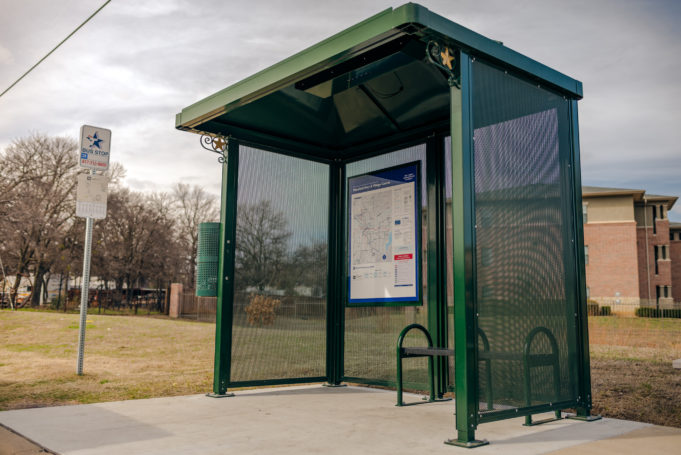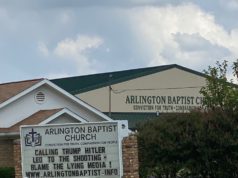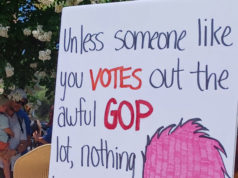Some business owners along the West 7th Street corridor were less than thrilled after a rumor began spreading that Trinity Metro – formerly known as The T – was going to build sheltered bus stops along the strip. People who live and work along Fort Worth’s version of the Sunset Strip appreciate buses but don’t like the idea of sheltered stops clogging the sidewalks. And they don’t like being left out of the loop when transportation officials are making decisions that impact their businesses.
Another business operator who asked for anonymity said he had heard that the sheltered bus stops were going to be made of concrete. That rumor made its way to Max Holderby, who chairs the Cultural District Alliance group that represents stakeholders. We contacted him on the phone while he was on an out-of-town business trip.
“We know very little about these bus stops,” he said. “We’ve heard them described as concrete bunkers. It doesn’t sound like anything that’s needed in the Cultural District. I’ve never seen a sketch or photograph or anything.”
Questions are many. How large will the shelters be? Will they obstruct the view of motorists pulling in and out of parking lots? Will people waiting at the shelters create litter? Will homeless people sleep in them at night? Will crime increase?
“I don’t want to jump to the conclusion that it’s horrible just because it’s called a concrete bunker,” Holderby said. “But if it doesn’t have visibility going through it, you don’t want a place where people can be hidden. There is safety in visibility.”
Seems rumors of concrete bunkers might have been overblown. Or fabricated completely.
“Where would somebody hear that?” said Rebecca Young Montgomery, vice president of external affairs at Trinity Metro. “That’s just so farfetched.”
Trinity Metro will be adding more than 100 new bus shelters along various bus routes around the city, but the only concrete used is on the pads, she said. The shelters will be made with metal frames and see-through sides.
“They are like the ones downtown, very clean, aesthetic, sleek looking,” she said. “They will have solar-powered lighting.”
Currently, about 2,000 bus stops are scattered around the city. Only about 180 of them are sheltered. Riders enjoy being able to avoid inclement weather while waiting for buses, but the covered shelters cost about $10,000 each to install, Montgomery said.
“It’s not something we can put everywhere,” Montgomery said.
Residents have told city officials they want a better public transportation experience, including bus stops that include more than just a sign by the road. They want seating, shelter, and lights. And they want them at busy spots near retailers.
“Trinity Metro is trying to focus on improving the transit experience in Fort Worth,” said City Councilmember Ann Zadeh, whose district includes the West 7th corridor. “We’ve heard numerous times from people that the experience of taking public transportation in Fort Worth is less than desirable because you have to stand out in the weather.”
Managers at the mostly high-rent residential properties in the area say their tenants are unlikely to use the bus and don’t want elaborate bus stops nearby. A manager said he spoke to a neighborhood police officer about the sheltered bus stops, and the cop was worried, too.
“The local police down here do not want them,” he said. “They said they are struggling with the homeless people because downtown is pushing them out toward 7th Street. Now [homeless people] are behind Target, because it is all overgrown back there. The police officers are concerned they are going to start living in these covered shelters.”
Zadeh has heard worries about transients littering and sneaking into the shelters for nighttime sleeping.
“Those are definitely concerns that need to be dealt with,” she said. “But I don’t think its something that should stop us from making improvements to the public transportation system so that it can serve people who are transit dependent as well as people who are choice-riders. Choice-riders will make the choice to use public transit as we improve the rider experience.”
The bus stops are necessary and welcome, Holderby said. Many of the service workers at the bars, restaurants, and hotels use them during their daily commutes.
“I see a lot of people using them,” he said. “It seems like a great opportunity to develop something that is economical, safe, and helpful for people that depend on mass transit.”
Editor’s note: Ann Zadeh’s name was misspelled in an earlier version. Static regrets the error.













This was an interesting article that raises important issues.
Based on our experience downtown, the design of a bus passenger shelter can discourage unwanted behavior. Trinity Metro has been receptive to design input and they understand the importance design plays in the success of their shelters for passengers and neighborhoods.
Creating a comfortable, convenient transit system will increase broader public use, growing the constituency for transit – an important ingredient in Fort Worth’s transit future. Trinity Metro’s intent to add shelters is a direct response to the public’s feedback during their Master Plan process. They are adding improvements that make transit more appealing for all.
Fear that passenger shelters are going to “attract” homeless people is unfounded…if they are designed appropriately.
As for downtown “pushing (homeless) out toward west 7th,” this is not true. Police and Sheriff personnel, DFWI’s Ambassador team and private security have worked together for years to ensure that people in downtown obey the law. No one is being “pushed” to W7th. In fact, DFWI has a contract with DRC to provide homelessness outreach services. When we find people in crisis, DRC case workers assess the situation and help find the services they need ranging from emergency shelter, ID, rapid rehousing, mental health or chemical dependency assistance.
Nationwide and locally, increased housing costs, reduced inmate populations, the national mental health crisis, domestic violence, housing challenges faced by those with felony convictions and an escalating opioid epidemic contribute to the homelessness problem. The police working in the W7th area are struggling because the homeless population is growing, and Fort Worth’s popular destinations are magnets. Not because downtown is “pushing” them there. That quick excuse does a great disservice to what we do, but more importantly, it masks the more urgent homelessness issues.
Homelessness is a thorny issue that the City of Fort Worth, Arlington and Tarrant County have recently taken bold steps to engage through the reconstitution of the Continuum of Care. Much more needs to be done.
Andy Taft, President
Downtown Fort Worth, Inc.
Seems every time I pass a bus it is empty or perhaps one or two riders.
Rolling along, burning fuel, empty.